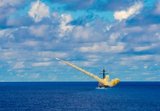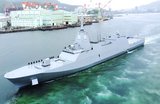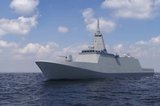Double success for MBDA’s Sea Ceptor system
Two guided firings of the Sea Ceptor air defence system have been successfully carried out by MBDA, demonstrating the functionality of the system’s Command and Control (C2) system. The firings were conducted on 29 May and 5 June at the land-based Vidsel range facilities in Sweden.
This was the first seeker guided firings for the Common Anti-air Modular Missile (CAMM), including using its two-way data link to communicate with the Sea Ceptor system, with the C2 system demonstrating its ability to process data from a third party radar and then command an engagement by a CAMM missile.
According to MBDA, the CAMMs performed as expected, with their active Radio Frequency (RF) seeker acquiring the targets shortly after launch and staying in track until they intercepted their respective targets.
CAMM is under development for the Royal Navy and Royal New Zealand Navy in the Sea Ceptor system and the British Army with the Future Local Area Air Defence System (FLAADS) Land system.
Sea Ceptor secured its first export order with the signing of a contract on 21st May 2014 for the Royal New Zealand Navy. FLAADS Land entered its Assessment Phase with the signing of a contract with the UK Ministry of Defence on 22nd January 2014.
Dave Armstrong, group director for short and medium range missiles, MBDA, said: ‘The success of these two firings is a major step forward for the Sea Ceptor programme and the CAMM missile, and directly benefits the associated FLAADS Land equivalent. It is also instrumental in proving that the UK MoD’s Portfolio Management Agreement with MBDA can develop complex weapons through the use of commonality and modularity, and do so in an affordable manner.’
The Portfolio Management Agreement (PMA) between the UK MOD and MBDA provides a contractual framework for the long-term acquisition of the UK’s Complex Weapon military capability, which aims to improve flexibility and reduce cost.
These latest firings build on a previous campaign of successful CAMM instrumented firings completed in April 2013, as well as extensive seeker data gathering trials.
More from Naval Warfare
-
![NATO tests use of “undetectable, jam-proof” laser communication in maritime scenarios]()
NATO tests use of “undetectable, jam-proof” laser communication in maritime scenarios
As part of its effort to better prepare its capabilities for operations in contested and congested scenarios, NATO evaluated a Lithuanian ship-to-ship terminal designed to not be susceptible to enemy interference.
-
![Mitsubishi eyes future with Australia’s Mogami selection]()
Mitsubishi eyes future with Australia’s Mogami selection
With Australia’s selection of the Mogami-class for Project Sea 3000, Mitsubishi is investigating local production in the next decade as potential export opportunities emerge.
-
![Thales’ new Sonar 76Nano could equip UK Royal Navy on anti-submarine warfare missions]()
Thales’ new Sonar 76Nano could equip UK Royal Navy on anti-submarine warfare missions
The new sonar is designed to equip uncrewed underwater vessels, with the potential to be used by the Royal Navy for its Atlantic Bastion and Atlantic Net missions.






















